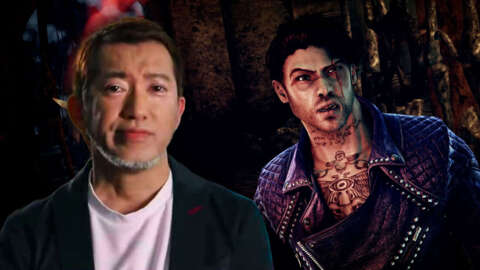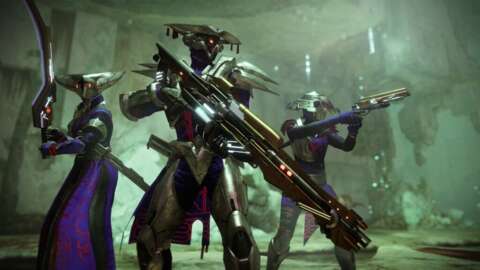Shadows of the Damned is a game where protagonist Garcia Hotspur’s gun is called the Boner, and he refers to vine-like blockades in the hell as “demon pubes.” It’s a game that confidently wears its video-game-y-ness on its purple leather studded sleeve, right next to Joy Division’s lyrics “Love Will Tear Us Apart” painted in thick white paint. From demonic enemies whom burst with collectible diamonds after shooting their heads off, to bosses covered in big, obvious “please-shoot-here” weak points, Shadows of the Damned: Hella Remastered isn’t just a reminder of its brash conviction in knowing its a video game or how un-seriously it takes itself, but a window into how far and how little video games have come since its original release in 2011.
Speaking with GameSpot at Gamescom 2024, producer and Resident Evil creator Shinji Mikami said, “[Shadows of the Damned] is aware that it’s a video game, and it’s not trying to be something else. There’s a lot of games these days that tend to take themselves a bit too seriously.”
When considering the state of action-horror games of recent, like last year’s Resident Evil 4 remake or Alan Wake 2, there’s an attention to detail and believability that both games feature in their combat and graphics. Both games have lifelike movement that add a sense of weight to your actions, offering realistic feedback regardless of if you’re getting a hatchet to the face or shooting a hole through an enemy’s head. The graphical fidelity of both games creates believable worlds that closely mirror our own. Shadows of the Damned: Hella Remastered has similar traits to both Resident Evil 4 remake and Alan Wake 2–the over-the-shoulder perspective, fending off enemy monstrosities, and even some puzzle elements–but it accomplishes it with a brighter color palette, cartoonish animations, and a don’t-give-a-shit attitude that evokes its own flavor of confidence.
Shadows of the Damned adapted many of those traits from the original Resident Evil 4, also produced by Mikami, but it actually has more in common with Alan Wake 2 in terms of combat design. Both Alan Wake 2 and Shadows of the Damned require cleansing its enemies of a darkness-like presence before being able to deal damage, as well as have a dedicated melee attack and a dodge button. The difference is that Shadows of the Damned isn’t mirroring a world we currently live in–instead, it’s a colorful and vibrant hellscape, where you’re drinking sake to heal yourself and feeding strawberries to demon babies to unlock doors.
A lot of games, especially now with the specs available, they go for this sort of hyper-reality. We don’t really care about hyper-reality.
Goichi “Suda51” Suda
It was through this lens that it first occurred to me how little has actually changed in the action-horror genre in terms of combat over the last 13 years–an entertaining notion given how often some players regard the standard game-design practices from that era as “arcade-y.”
“I feel that 13 years ago, when we were making the original [Shadows of the Damned], there were a lot of things in game development that were kind of just a given at the time,” Mikimi-san explained. “‘This is how you make games, this is what games are supposed to be like.’ A lot of things have changed since then. There’s a lot of stuff in Shadows of the Damned that’s a lot more casual and comical, and it’s just easy to enjoy without trying to take the game too seriously, or without the game taking itself too seriously as well. So hopefully that’s something that’ll resonate with modern-day players as something that isn’t maybe seen as much as it used to be, because back in the day, that’s just how video games were.”
Shadows of the Damned: Hella Remastered
Writer of Shadows of the Damned and founder of developer Grasshopper Manufacture Goichi “Suda51” Suda weighed in on the current state of realism in games today, saying, “I feel that a lot of games these days try really hard to go for a sense of reality. A lot of games, especially now with the specs available, they go for this sort of hyper-reality. We don’t really care about hyper-reality.”
For Grasshopper Manufacture, its philosophy is to present the game in “the most expressive way possible,” according to Suda.
While Shadows of the Damned: Hella Remastered is getting a 4K overhaul to its resolution, it’s hard to distinguish the game’s visuals from its original 2011, and it’s better off for it. The game’s reliance on bright colors and exaggerated character movements has allowed it to stand the test of time. While deft art design can have that lasting effect, game design tends to show its age with time. But to my surprise, Shadows of Damned: Hella Remastered seems to be holding its own in this corner of the ring as well.
In the 30 minutes I played, I saw a wide array of enemy types, varied environmental puzzles, and a clever use of its light and dark mechanics that kept me on my toes. The whole chapter was carefully paced, and felt considerably honed in. All these elements were in the original, too, but I had forgotten over the 13 years since I last played it. It was a welcoming surprise–a feeling that Suda himself had as well when returning to his 2011 cult classic.
“There’s definitely things that have changed the way I view the game and the things that I think I pick up on when I’m looking at the game now,” Suda-san said. “One thing looking at the game now: I actually feel that it was a lot more well-made than I felt when it originally came out.”
“We’ve got another project we’re working on at the moment,” Suda continued. “It’s a new IP, and since we’re working on that while also doing the remaster, you end up sort of comparing and contrasting. So when working on this new IP, going back to work on the [Shadows of the Damned] remaster at the same time, there’s definitely things I picked up on now that I maybe didn’t pick up on back at the time. Like, ‘Oh, hey, this is maybe something we could have done a bit better, or this is something we could have changed.’ And conversely, ‘Oh, hey, this is something we can maybe take and kind of tweak to fit the new IP.'”
According to Suda, that was a “big nope” for Grasshopper Manufacturer.
Shadows of the Damned: Hella Remastered
“One of the main reasons that we wanted to put out the remaster was to get it on as many platforms as possible. Originally it was only on PS3 and Xbox 360, and if it was only gonna be on Origin, then that defeated the purpose, because it would further limit the number of people who would be able to play it.”
It wasn’t until Grasshopper Manufacture partnered with its current parent company NetEase–and after Origin was no longer a major focus for EA’s distribution–that the studio was able to work out a deal that granted it both the rights for the remaster and the game’s distribution.
Until now, Shadows of the Damned was only playable if you have a physical copy of the game, which severely limits its availability for new players to access the cult classic. Thankfully, Shadows of the Damned: Hella Remastered is expected to release October 31 for all modern platforms and PC.




